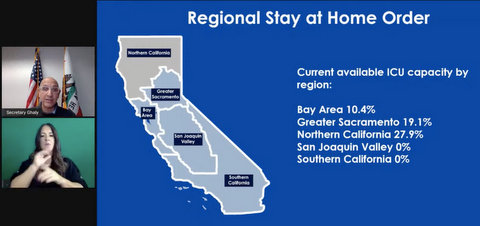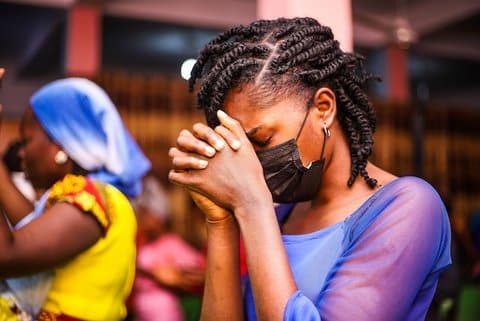
29 Dec Southern California and San Joaquin Valley to Remain Under Stay-at-Home Order

A region’s ICU capacity must be projected at or above 15% for four weeks to not be subject to California’s stay-at-home order. (Screenshot captured by Edward Booth / The CC Pulse)
By Edward Booth
The Southern California and San Joaquin Valley regions will remain under the state’s stay-at-home order for now, announced Health and Human Services Secretary Mark Ghaly on Tuesday.
The order initially went into effect in four out of five California regions — with the sparsely populated Northern California region, which holds about 2% of the state’s population, the sole exception — when intensive care unit capacity dropped below 15% in December. The San Joaquin Valley and Southern California were the first two regions to fall under the order, which lasts for a minimum of three weeks and remains until the state projects that ICU capacity will rise to 15% or above in the region.
“Today, the order will remain because those projections do not show that San Joaquin Valley and Southern California have projected, four weeks out, ICU capacity over 15%,” Ghaly said. “We essentially are projecting that the ICU capacity is not improving in Southern California and San Joaquin Valley, and that demand will continue to exceed capacity.”
The four-week ICU capacity projection that determines whether the stay-at-home order will remain in effect comes to the Greater Sacramento region Jan. 1 and to the Bay Area Jan. 8.
Currently, the Bay Area stands at 10.4% ICU capacity while the Greater Sacramento region stands at 19.1%. Once a region is released from the stay-at-home order, the state’s color-coded, tier-based Blueprint for a Safer Economy will come back into effect and determine which sectors of the economy may be open. This is unlikely to happen anytime soon for Southern California and the San Joaquin Valley, as both stand at 0% ICU capacity.
Ghaly said the San Joaquin Valley stands at a rate of 97.5 cases per 100,000 people each day, and the region carries a transmission rate of 1.13 cases per each case contracted. Southern California has a higher case rate, of 130.1 cases per 100,000 people each day, and a transmission rate of 1.10.
Assessments of the four-week projections will continue to be run on a daily basis, Ghaly said. They’re based on four regional inputs: Current ICU capacity, current 7-day average case rate, current transmission rate and current rate of ICU admission. If the region is projected to stay below 15%, the region remains restricted by the stay-at-home order.






No Comments